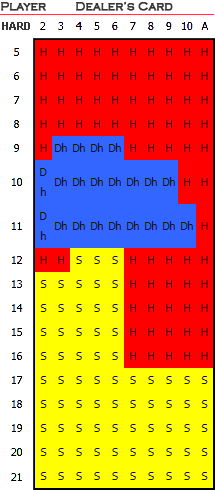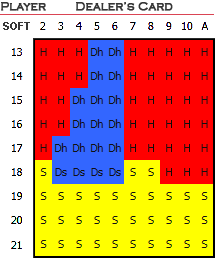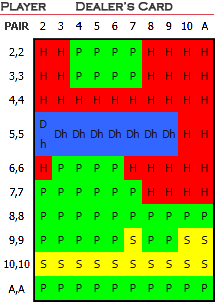Most players tend to know when to stand or hit, but when it comes to the terms double down in blackjack or splitting, it gets tricky. Some get timid and never utilise these options. Others go with their “gut feeling” and don’t follow any kind of strategy that makes sense.
The truth is, doubling down and splitting is not only a strong arsenal to beating the game, but also essential to maximising your profit and the RTP rate. So before you dive into real money play at live blackjack tables online, make sure you know when to double down and split.
Quick Links:
What Is Double Down in Blackjack?
What does double down mean in blackjack, you ask? It is an option offered right at the beginning of each hand, where the player gets to double the bet. In exchange, the player only gets to draw exactly one more card.
When Should You Double Down in Blackjack?
In theory, players should ALWAYS be doubling down in spots where taking exactly one more card has a winning percentage of over 50%, no matter how small that edge is. And that’s exactly what you’re supposed to do in this game. So, what are those spots?
They can actually be divided into two situations:
- Player is likely to make a very strong hand: There are more ten-value cards (10, J, Q, K) than any other card in the deck. Considering that, it is likely the player improves to a very strong hand by drawing one card if player’s hand total is 9, 10, or 11. In the first two cases, an ace will greatly help the player too.
- Dealer is likely to bust: Statistically speaking, dealer’s upcard 4, 5, and 6 are considered gems in this game. That is because there is a high probability of the dealer busting. Now, anyone can guess the player with a 9, 10, or 11 should be doubling down against these cards. But what about when you have a soft 13 or soft 18? It might be counterintuitive, but these are also spots you should be doubling down (with the exception of soft 13 against a dealer’s 4).
Double Down Strategy Chart
So, how do you decide exactly which spots you should be doubling down in blackjack? Don’t worry; smart people have already run the math and figured this out many decades ago. It has been compiled into a blackjack basic strategy chart.


Guide: H = Hit | S = Stand | P = Split | Dh = Double if possible, otherwise Hit | Ds = Double if possible, otherwise Stand
Different Rule Variations Involving Double Down in Blackjack
The more options the player has, the better payout the blackjack game offers. The universal (or the “classic”) rule allows doubling down on any two cards, also with the option after splitting.
Some of the new live tables, however, do not offer one or neither of these options, and that will lower the RTP approximately by 0.15%-0.40%. It might not sound like much, but if you care about maximising profit, make sure you read the table rules before making a wager.
Notable Spots to Double Down (or When Not to)
Remember, you’re always “expecting” to draw a 10-value card in blackjack, as 4 out of 13 cards are of that value. Same can be said for the dealer’s down card and the card(s) they are going to draw. Therefore, some situations are obviously ideal for doubling down to anyone’s eyes. Think about getting dealt a 9, 10, or 11 against the dealer’s 4, 5, or 6, for example.
Looking at the basic strategy chart though, you might find some spots that go against your instinct. The difference in player edge is likely only a few percent or less in these spots, but that can pile up in the long run. And in blackjack (or any form of gambling for that matter), you never want to miss out on these tiny edges. So let’s take a look at some situations that stand out.
(Almost) Always Double Down in Blackjack on an 11
It’s fairly obvious that the most ideal spot to double down is when the total of the player’s first two cards is 11. But when the dealer is showing a 10? Don’t be scared! Make sure you always double the wager!
The only exception is when the dealer is showing an ace. Even after the dealer has peeked and confirmed a non-blackjack, the ace is still a very strong card. In this case, keep hitting until you reach at least 17.
Slow Down Just a Bit on a 10
A 10 is a great hand to start with in blackjack. Not as good as an 11 though. Double down against the dealer’s 2-9, but when they’re showing a 10, it’s time to slow down. That’s because you’re drawing to a tie, in theory. Again, keep hitting until you reach at least 17. Likewise when the dealer is showing an ace. Also note that you’re always supposed to stand on a soft 20 (explained later in the section).
Doubling Down on a 9
9 is surely a strong hand, but you don’t want to get excited as much as when you have a 10 or 11. Only double down when the dealer is showing a 3, 4, 5, or 6. Beware you’re supposed to HIT when they’re showing a 2, unlike when you have a 10 or 11.
Doubling Down on Soft Hands
A hand consisting of an ace and a card(s) 9 or under is called a “soft hand” in blackjack. On the contrary, a hand without an ace is a “hard hand”. When it comes to doubling down, the soft hands are the trickiest. The reason for this is because you need a completely different mindset than if you have a normal hard hand.
While you’re doubling down with the expectation of improving to a very strong hand with your hard hands, you’re hoping the dealer will bust when you have a soft hand.
Let’s take a look at the strategy chart for soft hands. You can see when the dealer has a 5 or 6, you’re doubling down on A2, A3, A4, A5, A6, A7, and A8. Of course, there are some cards that can improve your hand to 20 or 21, but considering there are a lot more 10s in the deck, one can see the ideal strategy is not really looking to improve your hand to win.
Instead, the math says the dealer busts often enough to make this play profitable. Although not as often as against the dealer’s 5 or 6, you should be doubling down against their 3 and 4 also.
Always Stand on Soft 19 and 20
While you’re supposed to be doubling down on relatively “bad soft hands” against the dealer’s 3 – 6, you are to stand pat with soft 19 and soft 20, which can be counted as a 9 and 10, respectively (there is no such hand as a “soft 11” with the first two cards by the way, as that will be a natural blackjack). Again, this might sound counter-intuitive, but let’s be faithful to the mathematicians who did all the hard work.
Blackjack Double Down FAQ
Here are some frequently asked questions involving doubling down in blackjack, in case you’re looking for short, simple answers:
No, it's not. While doubling down is always offered as an optional action, it should always be used in certain spots where the player has an edge.
You can double your bet after the first two cards are dealt to you and the dealer. In return, you have to take exactly one more card.
This depends on the rule for each table. While most "classic" blackjack tables offer this option, it is not common in live dealer games. For instance, Evolution Gaming, industry's leading provider, does not allow doubling down after splitting in any of their blackjack variants.
No, it's not, although there were local casinos and RNG blackjack online games that offered this option in the past. The option is not offered on any of the live blackjack tables.
Technically you should be able to, although the player will be giving up a huge edge by doing so. Live blackjack games do not offer this option, however, to save time.
There are roughly two types of hands you should be doubling down with. One is when you have a very strong hand, and the other when you have a soft hand and the dealer has a very weak card showing. For further details, take a look at "When Should You Double Down in Blackjack?" on this page.
What Is a Split in Blackjack?
Split is another optional action offered in the game of blackjack, along with double down and insurance. Although insurance always has a negative expected value (so the option should never be used), splitting in the right spots is crucial in beating the game of blackjack.
Okay, let’s get down to the point. A split is allowed when the first two cards dealt to the player is of equal value (in other words, the cards are paired). The player can then double the wager and split the initial hand into two separate hands. The new hands will be played out like normal blackjack hands (except in situations explained later in this section). The dealer, by the way, never has the option to split.
When Should You Split in Blackjack?
Just like doubling down, players should ALWAYS be splitting in spots where the move creates an edge, no matter how small. So, what can those spots be?
This is a bit tricky. There are a couple of pairs you should always split and also never split. Other than these 4 combinations of pairs though, the decision depends on what the dealer’s upcard is. The easy-to-remember pairs are these:
Pair of As and 8s: Always Split
Instead of playing a pair of aces as a 2 or 12, you should always split them and try to nail a 10. Splitting aces has an exceptional rule though, and only one more card can be taken for each ace. Also, nailing a 10 does not constitute a natural blackjack; therefore a normal 1:1 will be paid out.
Meanwhile, 16 is the worst hand to be dealt in blackjack. You’re lucky though, if it turns out to be a pair of 8s. Go ahead and split them apart, and start over with two fresh hands from an 8, even when the dealer is showing a scary card like a 10 or an ace.
Pair of 10s and 5s: Never Split
When you have a pair of 10s (any mixed combination of 10, J, Q, or K), you already have 20, which is a very strong hand. Stand and pray your hand is good as is.
Somewhat relevant, a pair of 5s equals a 10, presenting a great opportunity for improvement on its own. You don’t want to be splitting them in to two 5s. Instead, play it out like it’s just another 10. That is, you double down unless the dealer is showing a 10 or an ace.
Pair Strategy Chart
For other pairs, the use of a strategy chart is a must, unless you are some kind of genius. There is a separate basic strategy chart created specifically for dealt pairs.
The following chart is for tables where double down after split is not allowed, which is the most common rule in live blackjack games.

Guide: H = Hit | S = Stand | P = Split | Dh = Double if possible, otherwise Hit | Ds = Double if possible, otherwise Stand
Different Rule Variations Regarding Splits
Like the double down rule, each table or game provider might have restrictions on splitting.
One becoming common in live blackjack games is the no-double-down-after-split rule. It is enforced on every Evolution table, and unfortunately it slightly shaves the player edge, even though by a tiny 0.15%.
Another restriction that might be in play is the number of times a player can split on one hand. Re-splitting is never allowed in some cases, while in others, re-splitting is allowed only once.
Differences in Strategy if Double Down After Split is Allowed
Let’s say you luckily found a generous blackjack table that allows unlimited number of splits and double down after splitting. Will you be using the same strategy chart?
As for unlimited number of splits, you don’t have to worry abut it. The strategy stays the same, no matter how many times you can split on one hand.
On the other hand, if double down is allowed after a split, you need to make some tweaks to it. In each case, the difference in strategy comes from the increased chances and edges of doubling down after the split. These differences are:
- Split pairs of 2s and 3s against the dealer’s 2 or 3: While these pairs are always to be split against the dealer’s 4-7 regardless of the rule, more splitting situations arise.
- Split pairs of 4s against the dealer’s 5 or 6: Yes, dealer showing a 5 or 6 is optimal. You want to break up an 8 and try to nail a double down opportunity. You can never be too greedy when you’re trying to take money from the house.
- Split pairs of 6s against the dealer’s 2: This must be the most counter-intuitive one. It doesn’t really look optimal, but the math says otherwise.
Blackjack Split FAQ
Here are some frequently asked questions regarding splitting in blackjack:
Yes, it is. However, while it sounds more like a side bet, there are situations where you should always split. These are spots where splitting increases your overall odds of winning.
Split can only be done when a pair is dealt to the player. By doubling the initial wager, the player gets to split the pair into two separate hands and plays on from there.
The answer depends on the rule of each table. While most traditional blackjack tables allow unlimited number of splits for one hand, some do not allow re-splitting, or others offer re-splitting only once. Meanwhile, splitting aces is limited to one time per hand.
Even if you draw a 10 after splitting aces, the hand is no longer considered natural. Therefore the hand will be played out just as a normal 21 and you'll get paid 1:1 if you win.
Technically yes, you can, but that will cost you a lot in the long run. Always stand pat on a 20 if you like winning.